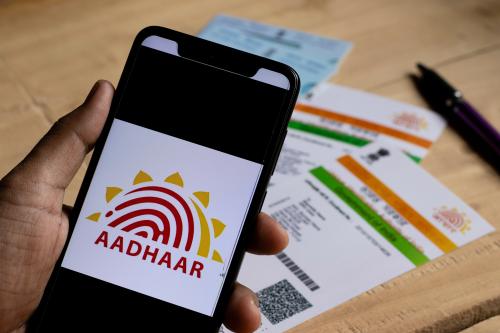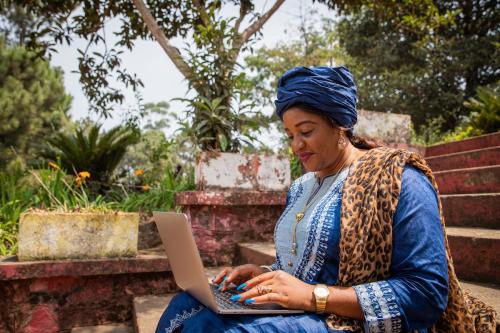Executive summary
Rapid shifts in digital technologies are changing the context for pursuing the Sustainable Development Goals (SDGs). In the best cases, these technologies have contributed to massive improvements in access to public services and economic opportunities for millions of people. In the worst cases, they have opened the door to new forms of government surveillance, exacerbated inequalities, and encouraged social divisions. Many private firms also have enormous influence in shaping the interface between digital technology and societal well-being. Against this backdrop, a growing movement is emphasizing the need for digital public goods and digital public infrastructure.
This paper focuses on “digital public technology” (DPT), meaning digital assets that create a level playing field for broad access or use—by virtue of being publicly owned, publicly regulated, or open source. We consider how they could support greater progress toward the SDGs’ overarching 2030 deadline, with an emphasis on issues of extreme deprivation and basic needs. None of the relevant SDG indicators are fully on course for success by 2030, although some—like child mortality, access to electricity, access to sanitation, and access to drinking water—are on track to achieve gains for more than half the relevant populations in need. Some indicators are on a path to less than half the needed gains, including stunting, extreme income poverty, maternal mortality, access to family planning, primary school completion, and non-communicable disease mortality. Other issues like undernourishment and children overweight are moving backwards.
The human scale of the SDG shortfall is substantial. For example, over the period 2016-2030, the gap adds up to more than 15 million children under 5 dying and more than 40 million people dying early from noncommunicable diseases. In 2030, more than 1.1 billion people are on course to lack access to sanitation, nearly 780 million people will likely be undernourished, and around 570 million people will still live in extreme poverty. Many of these challenges are highly concentrated in a small number of populous countries, including the Democratic Republic of the Congo, Nigeria, India, and Pakistan. Many other smaller countries, such as South Sudan, Chad, and Central African Republic, are also severely off-track on many SDG targets.
There is no singular relationship between access to digital technologies and SDG outcomes. Country- and issue-specific assessments are essential. Sound approaches will frequently depend on the underlying physical infrastructure and economic systems. Rwanda, for instance, has made tremendous progress on SDG health indicators despite high rates of income poverty and internet poverty. This contrasts with Burkina Faso, which has lower income poverty and internet poverty but higher child mortality.
We draw from an OECD typology to identify three layers of a digital ecosystem: Physical infrastructure, platform infrastructure, and apps-level products. Physical and platform layers of digital infrastructure provide the rules, standards, and security guarantees so that local market innovators and governments can develop new ideas more rapidly to meet ever-changing circumstances. We emphasize five forms of DPT platform infrastructure that can play important roles in supporting SDG acceleration:
- Personal identification and registration infrastructure allows citizens and organizations to have equal access to basic rights and services;
- Payments infrastructure enables efficient resource transfer with low transaction costs;
- Knowledge infrastructure links educational resources and data sets in an open or permissioned way;
- Data exchange infrastructure enables interoperability of independent databases; and
- Mapping infrastructure intersects with data exchange platforms to empower geospatially enabled diagnostics and service delivery opportunities.
Each of these platform types can contribute directly or indirectly to a range of SDG outcomes. For example, a person’s ability to register their identity with public sector entities is fundamental to everything from a birth certificate (SDG target 16.9) to a land title (SDG 1.4), bank account (SDG 8.10), driver’s license, or government-sponsored social protection (SDG 1.3). It can also ensure access to publicly available basic services, such as access to public schools (SDG 4.1) and health clinics (SDG 3.8).
At least three levers can help “level the playing field” such that a wide array of service providers can use the physical and platform layers of digital infrastructure equally: (1) public ownership and governance; (2) public regulation; and (3) open code, standards, and protocols. In practice, DPTs are typically built and deployed through a mix of levers, enabling different public and private actors to extract benefits through unique pathways.
The design and deployment of DPTs often raise considerable challenges. At an operational level, these might include a lack of financial sustainability, limited capabilities within government to oversee a platform, and government procurement obstacles. DPTs can also undermine SDG outcomes if they compound inequities in digital access, contribute to concentrations of power in any public or private entities, or lead to misuse and abuse of individuals’ data.
Amid the rapidly evolving context for DPTs to make potential contributions to the SDGs, few official donor organizations have so far made digital development a strategic priority. Robust official statistics are not available, but one estimate suggests relevant funding rose to $6.8 billion in 2019, with multilateral institutions providing more than bilateral donors. A few large private philanthropies appear to be placing greater relative priority on digital technology within their own resources, with estimated funding adding up to $491 million in 2019.
As fast-changing digital technologies penetrate more dimensions of all societies, successful DPT strategies will require multi-pronged approaches that promote benefits while mitigating risks. Governments can establish participatory design processes and citizen-centric data governance regimes while ensuring accountability and redressal systems. Civil society can represent diverse voices in policy making, while spreading digital literacy and holding governments accountable. Funders can finance risk-based support frameworks while prioritizing the sustainability of interoperable, well-governed DPTs and investing in ecosystem players. A holistic approach to DPTs could help accelerate progress on many SDGs as the world approaches its 2030 deadline.








